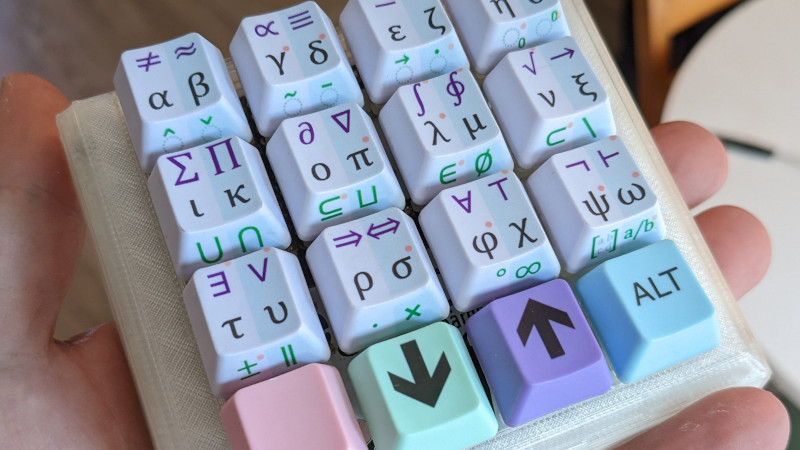For those of us with science and engineering backgrounds, opening the character map or memorizing the Unicode shortcuts for various symbols is a tedious but familiar part of writing reports or presentations. [Magne Lauritzen] thought there had to be a better way and developed the Mathboard.
With more than 80 “of the most commonly used mathematical operators” and the entire Greek alphabet, the Mathboard could prove very useful to a wide number of disciplines. Hardware-wise, the Mathboard is a 4×4 macro pad, but the special sauce is in the key set implementation firmware. While the most straightforward approach would be to pick 16 or 32 symbols for the board, [Magne] felt that didn’t do the wide range of Unicode symbols justice. By implementing a system of columns and layers, he was able to get 6+ symbols per key, giving a much greater breadth of symbols than just 16 keys and a shift layer. The symbols with a dot next to them unlock variants of that symbol by double or triple-tapping the key. For instance, a lower or capital case of a Greek letter.
The Mathboard currently works in Microsoft Office’s equation editor and as a plain-text Unicode board. [Magne] is currently working on LaTeX support and hopes to add Open Office support in the future. This device was an honorable mention in our Odd Inputs and Peculiar Peripherals Contest. If you’d like to see another interesting math-themed board, check out the one on the MCM/70 from 1974.















Lilac and lavender coloured modifier keys… Straight HP48GX vibes!
12 * (2^4) < 12 * 6
I feel a bit disappointed about the efficiency. ;-)
(Cool build, like it, looks really usable)
Ups , sitting on a qwertz keyboard. Meant SHIFT+<
Why no ꭥ ?
It’s there; lower case omicron (sorry, not sure the alt code but looks like a ‘w’)
Whups, I am wrong. It is on the keypad as lower case Omega (looks like a ‘w’)
I’ll put on my asbestos shorts and say:
I have one word for you: LaTeX
> [Magne] is currently working on LaTeX support
Thanks.
In my world it is practically mandatory that everything that’s not on the back of a napkin is typed in LaTeX. Even my homeworks as an undergrad had to be …
I was hoping to find a quick description of how this works without resorting to searching the source code. I was pretty disappointed the day I learned that keyboards don’t send the actual UTF characters being typed but rather keycodes which are basically button positions. I had hoped to be able to be able to build a supplemental keyboard with math and foreign language symbols.
So instead I started memorizing Compose Key sequences.
Apparently that’s also how this macro pad works.
“Compatibility
The mathboard works on Unix systems (including Apple Mac OS) and Windows. When using the Mathboard on Windows, the open source application WinCompose must be installed and running.”
So I guess it’s just sending the appropriate Compose Key sequences? That’s cool.
But what’s this stuff about LaTex, MS&Open Offices, etc… Does it somehow know when the user is in one of those programs and send a different set of key sequences? If so then how? That sounds like an interesting hack worthy of some discussion!
I took that to mean rather the inverse: that some sort of interpreter would be added to those applications to tell the app what to do with data from this device.
DuckyPad has software to do that kind of thing actually. Not sure if I can post a link to it, but it’s always being advertised on the HaD homepage. I have one, and there is software that detects what program has focus and changes the keypad profile accordingly.
Anyone noticed the creator has mixed up the Greek alphabet?
Omicron/Pi and Rho/Sigma are in the wrong places.
Thanks for pointing that out!
So support is /input{mycommands.tex}?
If I were to do this – and it does seem like a useful thing – I would use switches with clear removable caps that allow you to change the legend without having to order custom dye-sub caps.
How/where did you get the custom symbols printed on the keycaps?
I had them printed with a UV printer. The prints are very durable on the white keys, but on the colored keys they tend to come off after not very much use.